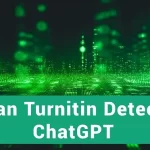Are you a thriving part of the content creation industry? If yes, you must have gotten that dreaded message, “Did you use AI to create this content?”
In one second, all your efforts and long nights of research are wiped away. That’s because the AI detector tools flag even the most original content as AI content. The AI detectors have become a nightmare for content creators. For this reason, many of them wonder, “How do AI detectors work?”
That’s because they help in figuring out how they can bypass these checks. It’s evident that these tools are new and are based on experiments. Consequently, one cannot believe that they will be 100% accurate. So, let’s see how these AI detectors operate!
How Does An AI Detector Work?
AI detectors depend on a language model. These models are the base of detection tools – these models are similar to the ones used in AI content generation tools. When you paste content to detect AI, it asks itself, “Is this the kind of content I could have created?” If you give a nod, it flags the content as AI’s doing.
In particular, these detection tools use burstiness and perplexity. These are two variables, and the percentage has to be high. In simpler words, if the percentage of these variables is low, there is a high chance that content is created by AI.
Burstiness
This variable checks the sentence length, along with the structure. It identifies variations in the structure and length. For instance, if the text doesn’t have many changes in structure and size, it means a low burstiness percentage. Contrarily, if the changes are too much, it leads to high burstiness. To illustrate, AI content has a low level of burstiness as compared to human content.
The language models can predict the next word that will be used in the sentence. In addition, the AI tools usually create sentences between 10 and 20 words. Also, the sentence structure is pretty conventional. As a result, the AI content feels monotonous. Overall, the high burstiness is an indication of human content.
Perplexity
It checks unpredictability of the content. To illustrate, it shows how much content can confuse (perplex) the readers. In simpler words, the content will not feel natural or won’t make sense. The human content tends to have a higher percentage of perplexity. This is because human content creators use creative language and might make more mistakes.
The detector tools predict what words are normally used in a sentence. Overall, a low perplexity percentage means that an AI tool was leveraged.
Bonus – Don’t Forget about Watermarks
While perplexity and burstiness are the common variables, watermarks will be the future. OpenAI is creating a watermarking system where AI content will have an invisible watermark. These invisible watermarks can be detected by detection tools to ensure 100% accurate results. However, this technology isn’t ready yet, and its mechanism isn’t finalized yet. So, let’s keep our fingers crossed!
Manual Detection of AI Content
Now that it’s clear how AI writing is detected, it’s evident that the results aren’t always accurate. So, that’s the reason the majority depends on manual detection. There are some identifying features (or giveaways) of AI content. Truth be told, manual detection is challenging, but you will be able to develop an instinct with time. As a layman, it will be difficult to focus on burstiness and perplexity as they are technical.
Usually, you’ve to look for content with monotonous sentences. For instance, there won’t be any variation in sentence length or structure. However, you’ve to look out for some pointers, such as;
Extra Polite Language
First of all, the content generation tools are meant to become your assistants. For this reason, they always use polite language. In some cases, the language feels too formal as well. In simpler words, the content won’t be conversational.
Absence of Sources & Citations
If you use content generation tools for academic writing, the absence of sources and citations will mean AI. This is because academic assignments and papers are incomplete without sources and citations. Having said that, the AI content generation tools don’t cite the sources or don’t do them correctly. Usually, they end up citing sources that don’t exist at all.
Hedging Language
The hedging language usually includes “Some people may say that” or “It’s important to state that.” There won’t be any original or bold sentences in the content that’s generated by AI tools.
Logical Errors
The AI content has a lot of consistency, but there is no coherence. In particular, you should look for the parts that have contraction. For instance, if the sentences aren’t connected or the statements are questionable, it means AI was used.
Voice-Related Inconsistency
If you are checking the content of someone whose style you are familiar with, you can check for consistency in their tone. For instance, you can compare their old work with the new. If the new work seems too artificial and formal, it means that they have used AI.
Overall, we also recommend using some AI content-generation tools. That’s because it can help determine what kind of content these tools generate. It will become easier to understand different writing styles. As a result, it will become easier to spot the AI content.
What about AI Video & Image Detectors?
While text detection tools are common, there is an increasing need for video and image detectors as well. That’s because the tools like DALL-E and Midjourney are gaining popularity. These tools are used for generating images and videos. These types of content is known as deepfakes. However, the AI detector tools for videos and pictures aren’t accurate.
To detect such content, you should look at hands, as AI pictures/videos will have extra fingers. In addition, the faces won’t be convincing, and the text will not make sense. However, AI generation tools are becoming better, so manual detection will become difficult. So, some of the suitable detection tools include Illuminarty and Deepware.
Accuracy of AI Detection Tools – Is It Reliable?
We cannot answer on reliability, but it’s needless to say that results aren’t always 100% accurate. The results depend on the confidence in the model rather than the content. For instance, when you check the content, it calculates the probability of every classification it has been trained on. These tools categorize the content into AI and humans. It calculates the probability scores. In addition, it checks how far or close these scores are.
The Best AI Detector Tools to Use
Right now, you must know “What do AI detectors look for?” The next step is to find the AI detector tools to check the content. Honestly, there are hundreds of tools out there, but not all of them are bad. Some of them are more reliable (still not 100% accurate). So, let’s check out the best AI detectors one can use.
Quetext
While this tool is famous for plagiarism detection, it has launched a new feature. This feature helps detect the use of AI generation tools. It has a deep search technology that identifies if the content is coming from sources other than humans. In addition, they use a combination of contextual analysis and conditional scoring. Not to forget, it uses fuzzy matching.
They outline the plagiarized content, or you can use the citation generator to reduce the plagiarism level. Furthermore, it lowers the percentage of AI flagging. Given this point, it’s a nice option for copywriters, teachers, and students.
Originality.ai
This is the most popular tool for detecting AI content. It became popular as soon as ChatGPT came out because it can detect content created from GPT-4 and ChatGPT. It’s specifically designed for content writers, SEO managers, and content marketers. It ensures that writers aren’t using AI tools to generate text because it can lower the search engine ranking.
You can use it through a web app but a Google Chrome extension is in works too. This extension works in Google Sheets and Google Docs as well. In particular, this is a standout feature as it gives details about the content writing process. The best part is that the makers are updating it regularly, so there are lower chances of false positives.
Content At Scale
If you want an online tool to detect AI in content, this is a good option. This tool says that AI will become the future of SEO writing and it’s okay to accept it. However, it also accepts that Google will detect the AI content and lower the website ranking. Thus, website traffic will decrease, leading to low sales volume.
Content At Scale can identify patterns as well as the probability of AI in the content. If you want to use the AI content, you can use a specific formula to make it undetectable. It’s a good choice for copywriters only. However, students shouldn’t use it because it doesn’t work with formal or academic content.
Turnitin
It’s a well-known tool among academics because teachers and educators use it a lot. For the most part, it’s used by university and college teachers. It’s better to check AI in creative writing as well as assignments. In most cases, it’s used to determine plagiarism in the content by checking it against published papers.
In the end, it gives you a percentage of plagiarism and AI and outlines the parts. However, we don’t recommend it for non-academic content.
Generative AI
This is also an online tool that makes sure the writing doesn’t sound robotic before they hit the publish button. The algorithm is pretty strict, as it checks the content against thousands of blogs and articles. It will give you a percentage of AI content so you can redo the content.
The Future of AI Content Detector Tools
Knowing how do AI checkers work is one thing, but we cannot ignore the fact that they need to improve. It’s evident that AI tools are becoming more sophisticated. For this reason, it’s becoming difficult to detect the content. Similarly, the developers need to create accurate and cutting-edge tools to detect the content.
In addition, it’s important to outline incorrect or false information provided by the AI to maintain credibility. This is vital for countering the threats. On top of everything, you have to think about ethical factors around violating consent and privacy. Lastly, we have to think about the misuse of this advanced technology (it’s highly likely, right?).
Why Do AI Detectors Exist If They Aren’t Accurate?
The AI detectors are in demand because the users need control. For instance, if someone has hired a content writer for original content, they don’t want to be scammed by AI content. In simpler words, there is an evident need. Similarly, the developers are trying to create tools that meet this demand/need. In addition, they get paid when someone uses the tools.
It’s okay to use the AI detectors, but make sure you are focusing on manual checks as well. For instance, if the AI detection tool is giving a high score, you’ve to look at the following points:
- Are the stats and facts correct?
- Did someone turn around the assignment or task too quickly?
- Is there a surprising reduction in grammar and spelling errors?
- Is someone charging too little for the content?
These are some spot checks that will help you see if the content is created by a tool. In most cases, the factual errors give it away. However, never solely depend on the detection tools to finalize if the content should be published on the website or not. Instead, you must evaluate the content on your own. If you nod to any of these questions, go ahead with publishing!
- Are all the facts correct and have proper citations?
- Will the content help my audience or visitors?
- Is it according to the SEO standards?
- Is the content good enough to be associated with my brand/website?
How to Avoid the Detection of AI Content – The Ultimate Tips
Many writers are struggling with false accusations of using ChatGPT to create content. This accusation lowers their self-esteem a lot. The real issue is that detection tools aren’t fully accurate and give false positives. So, if you want to ensure that your content doesn’t get flagged, keep the following tips in mind!
Don’t Entirely Depend on AI Content Generating Tools
To begin with, you should be taking help from the AI tools rather than relying on them completely. To be precise, many people end up generating full articles and blogs from scratch. This is because such content will have incoherence, discrepancies, and never-ending repetition. These things can be easily caught on the content detector tools. It can also be bad for the overall reputation.
You should use these tools as assistants that make the job “easier” rather than doing the job completely. Remember that these tools won’t replace the writers and their creativity. Instead, it can be used as a way to overcome your writer’s block or create headlines.
Focus on the Content Structure
Poor structure is another giveaway of the excess use of AI generation tools. For instance, if you aren’t using human oversight, the content won’t have any depth or structure. A good piece of content should have enough spaces between paragraphs and images. In addition, the paragraphs are shorter to prevent monotonous content.
So, if you are creating content through these tools, always break down the paragraphs. In addition, you should use content optimization tools. They can catch extra-long sentences. Moreover, they provide suggestions related to spelling and grammar.
Use Diverse Vocabulary
When you keep using the tools to create content, certain words and ideas are repeated too much. This happens because these tools create content from the training data. As a result, they use words that are mostly used. Having said that, it’s important to use diverse vocabulary. For example, you can use the synonym of the same word if it’s becoming too repetitive.
Secondly, you have to change the impersonal or extra formal words. These words should be replaced with conversational words. In addition, try using the contractions, such as don’t and should’ve.
Check the Writing Style & Tone
One of the most vital parts is to ensure consistency in your writing style and tone. In particular, it should be according to the overall brand or website voice. It will help trick the detection tools and keep the website performance up. In fact, if your writing style and tone change out of nowhere, even your readers will notice it. As a result, they will think the content is half-hearted, hence no engagement.
Use the Right Prompts
Using AI generation tools might sound easy, but the quality of results depends on the prompts. For instance, if your writing style is similar to a famous blogger, add “write in the style of (add the blogger’s name.” This prompt will ensure that your writing has consistency.
Don’t Underestimate Editing
You cannot simply publish the content that an AI generator has created. That’s because these tools create robotic and dry content. These detection tools are very quick at catching such content. So, it’s time to focus on editing. Your goal should revolve around making content more natural and conversational. The simplest advice is, “Write as you are giving advice to your friend!”
Frequently Asked Questions
How accurate are the AI detectors?
They are accurate, but the percentage falls below 70%. The AI detectors keep an eye on vocabulary, sentence length, and coherence. However, they aren’t 100% accurate, which is why you must check the content’s legitimacy manually.
Using Quillbot paraphraser for AI content. Will detection tools detect it?
Yes, it can be detected by Turnitin. In addition, Originality.ai has a detection tool that determines if the content was paraphrased through Quillbot.
Is there a possibility of AI detectors being wrong?
Of course, the AI detectors aren’t 100% accurate. Many users have complained about false positives as well. This is a huge issue because these false positives are getting people fired, and students are getting suspended.
How can I trick the detection tools used for AI content?
We recommend using smaller sentences and reducing long pieces of content into easily digestible paragraphs. In addition, you should add personal perspectives and opinions. Lastly, don’t use the same words again and again – try using synonyms.
Can my university that I used ChatGPT to write assignments?
Yes, they can detect if the assignments are written by ChatGPT. Most commonly, they use Turnitin as they have recently launched the AI detection feature. Moreover, it can detect incorrect citations.
Is it considered cheating to use ChatGPT for work?
Of course, whether you are writing content for money or assignments for school, the content must be original. So, it is cheating if you use ChatGPT to create content. Also, if you are seeking help, always use citations to ensure credibility.
The Bottom Line
AI is a blessing, but it still cannot beat human-created content. The use of AI generation tools is increasing, so the demand for detection tools is also increasing. However, it’s no lie that these tools aren’t 100% accurate, so it’s time to evaluate the content manually as well. In simpler words, use technology, but don’t let it rule you!





